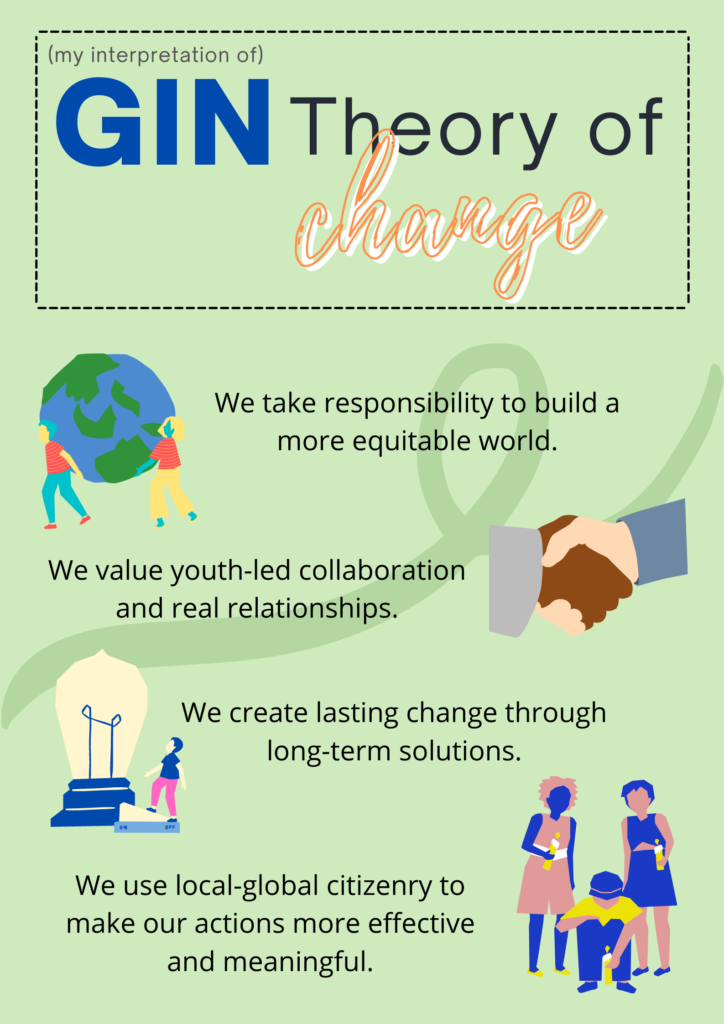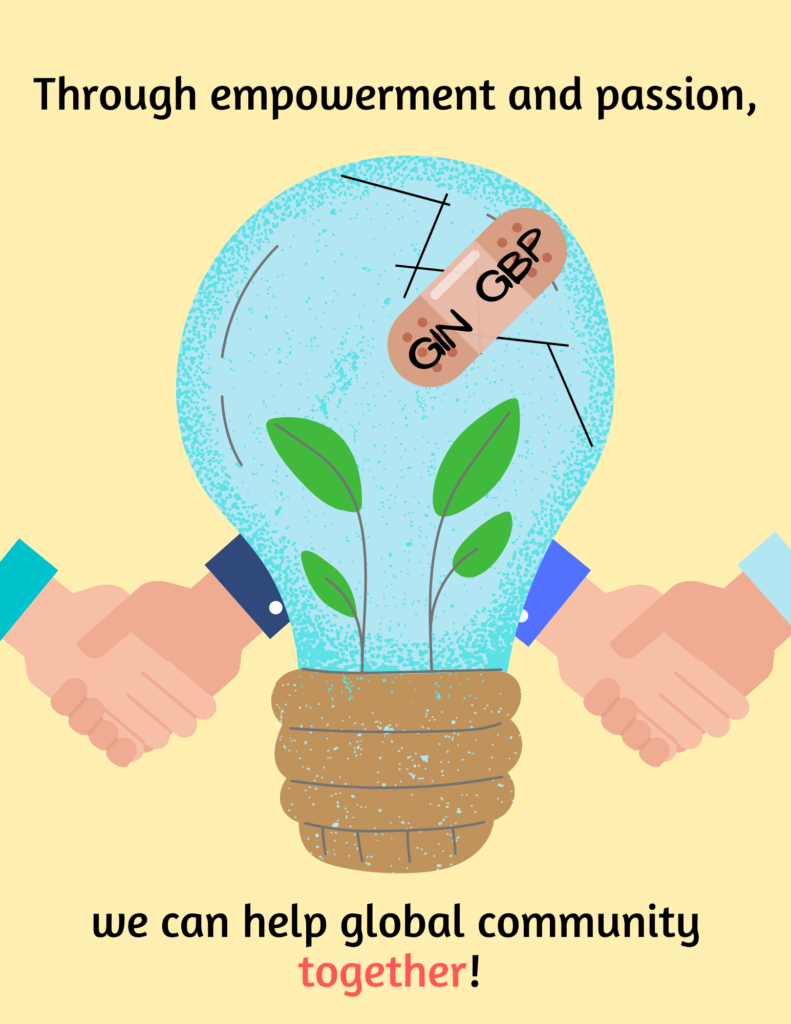Virtual Gallery Walk


Each Global Ambassadors Program and Global Bridge Program student created their own art piece that summarizes what they have learned from reading the GIN Theory of Change (excerpts can be found in Workbook 1 Chapters 1-2), how they personally identify with the ideas delineated in the GIN Theory of Change and how the Levels of Engagement support young changemakers as community organizers with impact. You can see their work below.
Sally S.

Support is a vital component of success. Without support, governments would fail, the economy would collapse, and chaos would erupt within every society. Even entire galaxies rely on support, i.e, gravity, to keep things from falling apart. However, support cannot exist without leadership. Who is there for us to support if no one takes the lead? What is there to support if there is nothing to look up to? GIN is all about support, leadership, and empowerment. Hence, all GIN projects are student-led, educator-mentored, and community-supported. In this image, a student leads the way up to the peak of the mountain. That flag is the goal the student aims to reach, the solution to an identified local-global issue. The educator-mentor provides opportunities and resources for the student to achieve their goal, and the mentor is represented by the backpack. The community seen at the base of the mountain cheers the student on. The ladder from the student shows that it takes a community to create lasting change. Therefore, everyone has to contribute to reaching that goal. Even though the youth are the leaders, it takes a community to actualize their vision of a sustainable and equitable society. I was inspired by a personal memory when creating this illustration. I went rock climbing for the first time on a school trip. I longed to reach the top, but I was unable to even lift a foot. I looked back and saw my peers cheering me on. I looked to my side, and my instructor told me that she will always be there to support me. I slowly inhaled the crisp air, lifted one foot at a time, and a few moments later, I had reached the top of the wall. This kind of support is needed to make progress. This kind of support is needed to achieve individual and team goals. One will have to persevere through obstacles, collaborate with the community, and create a lasting impact to bring truly meaningful change into the world.
Ashley B.

I find the GIN Theory of Change very inspiring. It’s an interesting way of seeing the world and our role in it. As I don’t consider myself a very artistic person, I decided to come up with something within my limits. The idea behind this poster was to summarize the main elements I see in the theory of change: world, collaboration, lasting change, and local-global citizenry. I was surprised to find this process quite challenging. Since the GIN Theory of Change has both depth and breadth, I had to choose which points I found the most valuable. I was also pleased to find images that represented the ideas I was trying to convey. To me, the GIN Theory of Change is a tool that we can use to empower ourselves by understanding the world we live in, its systems, and how we can create an impact. The first and most important step is to take responsibility. This is when we recognize that our future is up to us and the actions we take, and commit to making a difference. Change can only happen when we work collaboratively, which takes us to the next point. Fostering community relationships and communication ensures the work is equitable. Also, it’s important to make solutions long-lasting and consider their sustainability. The last part of the GIN Theory of Change that sticks out to me is local-global citizenry. Local-global citizenry means that your identity has a global and local side, and that you identify with struggles on a local and global scale. This is important because we can make our collaborative action more effective by thinking of the scale and context of where we are acting. My intention with this project is to spark discussion. When someone reads this summary of the GIN Theory of Change, they should be intrigued by the questions it raises. How do we create youth-led relationships? Why is sustainability important when thinking of lasting change? How do we create equity in our communities? What is local-global citizenry and how can we employ it?
Sofia R.

I created what I did the way that I did because I believe that a picture is really a thousand words. I am also more comfortable with using graphics to explain how being a local-global citizen important to me as a changemaker because I think that the pictures and cartoons I used perfectly explains what GIN GBP can do to help me become a local global citizen to become a changemaker; and that’s why it’s important to me. The very reason why it’s important to me is because being a local-global citizen helps put a Band-Aid or a solution over the world’s problems and GIN is trying to make those solutions sustainable. By being a local global citizen, we can fix more cracks and problems in the world. I created this because the lightbulb represents the world and the crack represents the problems in the world that we currently have. The band aid with the GIN GBP shows how GIN is trying to provide ways to fix those cracks and problems. I want my piece to convey that together (which is why there are people holding hands), we can do so much for this world and find means to fix what problems come about. This means to me that one person can try to fix the problems of the world, however, it is a lot more sustainable and a lot stronger if we all collaborate together our ideas to make sustainable solutions. The thoughts and emotions I have during this piece pretty much revolve around the urgency I have right now with all the problems we are going through in the world. This inspires and empowers me to do more than just an art work and actually use my time to take action. The story behind my piece is about trying to light the world up again by fixing the world’s broken lightbulb together. The world we live in is quite dark recently and I believe together we can make it brighter. I drew inspiration from other artworks that uses light as their symbolism.
Zohra J.

The Global Issues Network is an initiative created to empower youth-led projects and solutions to create an equitable future for the environment and society. GIN encourages the community to be dedicated and to work with the global community to achieve greatness and success. The meaning of GIN and the GAP program has been creatively illustrated in my art piece, through the loud words of what is being represented. Community, teamwork, communication, leaders; these words all have such a deeper meaning that truly impacts and effects how we work for the future, as well as some of the key GIN/GAP values. I have grasped the endless amounts of knowledge, facts, and lessons from the detailed lessons and texts in the workbooks, and the lively words stamped on my artwork represent all of that. A drawing can convey so much with so little, through the abstract lines and words, from the bold colors and flare. My artwork has demonstrated how communities are vital along with the help of a global connection. Communities help navigate who you are and what your best interest is. The community and importance of having a global connection with one another was my main idea and story behind the piece, including how all these elements are only achievable with a community; a family. Community is a vital and immense need to successfully create an equitable future, they provide new perspective and insight. Due to this, with more global leaders and thinkers, we will be able to develop innovative solutions and action plans in order to make our future communities sustainable. The artwork engages the thoughts on how we can further work to create equitable futures with the help of a global community and how a global perspective can make a bigger change. Additionally, the artwork demonstrates that to be successful and to achieve the GAP/GIN values, you need to have a dedicated, global community in order to successfully grasp and use all the vital elements- It is a visual representation on how equity and sustainability looks to me. The words shown in the piece denote the core values that come with a hardworking and inclusive community. Moreover, the importance of global opinion and perspective is another main aspect that is patent in the piece. Just like Margaret J Wheatley said, There is no power for change greater than a community discovering what it cares about.
Jeronimo M.

GIN has empowered me and our communities all around the world, to take action for the greater good, create projects that are sustainable, long-lasting, and have a real impact on the Local-Global communities that surround it. I believe that there are certain models and things, that a changemaker needs to know and embody, all of which can be learned from GIN. There needs to be an understanding of the LOE, GIN clubs, projects, sustainability, and equality in order for any project to succeed. As changemakers creating a long-lasting, measurable impact in our communities, that is based on GIN practices and models such as GIN clubs, projects, teamwork, sustainability, local-global change, and youth leaders is unusual, and goes against, and destroys older practices, beliefs, and stereotypes that say that our accomplishments are impossible. Key concepts are conveyed in the painting that I drew, but the most important one expresses that youth can take on the world and change the world for the better. Young changemakers have the ability to change old stereotypes, for the greater good, and in order to create a better place where future generations can live. By drawing the students holding the world up, it shows that the youth has the power to take the world, and shape it into what is best. Additionally, the image needed to convey the importance of GIN, and its key ideas, therefore I listed some of the most important things, all of which empower students to create change and help them create lasting sustainable solutions to real world problems. My artistic expression is represented as a painting that collects different techniques, such as paint, markers, and color pencils, all of which were used to create different pieces and aspects that make it what it is now. The idea with it was to create a very literal message explaining that if you follow the steps, and put in the work, you can take on the world with your hands and shape it for the best. The story behind it is that I had seen a picture at my school of poeple surrounding the world, and I wanted to change it so it would show how the Levels Of Engagement can take you to be the best local-global citizen, both as an individual and a changemaker.
Sofia M.

My artwork is called “The changemaker’s journey”. I used acrylic paint and a 40cm x 30cm canvas. I wanted to represent the journey GIN Students go through as changemakers. At the beginning of the storyline you will notice that the changemaker is wearing badges. The second frame zooms in on what those badges are. I tried my best to replicate the logos of GIN’s Best Practices. I painted this element onto the changemaker because I see Best Practices as values by which we need to operate at all times. I represented this by making the changemaker wear the badges all throughout his journey and even after he finished it. I see the GIN Theory of Change as a guide for changemakers. A guide to reach sustainable, real change while at the same time filling GIN Students with personal fulfilment. I wanted to represent how the LOE’s act as instructive steps telling you where to head next, that is why the changemaker is going up the stairs in the painting. Personally, this is how the GIN Theory of Change has helped me and my team grow. By illustrating the changemaker falling and getting back up I wanted to demonstrate the commitment we all must have towards empathetic and sustainable action. In this same moment, I also wanted to demonstrate how the support from your stakeholders motivates changemakers to keep getting back up despite adversity. At the end of the changemaker’s journey, you see a big smile on his face. I included this frame in order to represent how being a Local-Global Citizen positively affects you. Wait, how do we know he is a Local-Global Citizen? Well I tried to convey this by making his end result be to join the Global Network. What does the big smile mean? My intention was to illustrate the personal fulfillment one gets when you finally accomplish your long-term goals. Looking back to all the positive impact you’ve left on the people around you and acknowledging how much you’ve grown will surely bring happiness and fulfillment. I had a little journey of my own while working on the artwork. What surprised the most was that my vision for the painting actually worked. I wasn’t sure if the story would be understanded just by my drawings. When I finished it, I showed it to different people who haven’t seen the painting before and had them tell me what was going on in the story. This way I could test if it was clear enough to avoid adding text. Fortunately, everyone got it on the first “read”! I was so relieved and so ready to finally upload it. I hope you all like it as much as I do!
Ishika G.

I created a photo collage showing how I have become a local-global citizen. I put the image of the world at the top not only because it represents global citizenship, but because I have an international background. Being of Indian heritage, I was born in the US, living there for eight years before moving to Switzerland, where I have been for the past nine. I think various cultural contexts have fostered my interest in global issues. On the left, there is a symbol for the United Nations because Model UN first exposed me to international issues. There are also pictures of three female leaders that I have and continue to look up to: Malala Yousafzai, Smita Narula, and Jacinda Ardern. On the bottom left, I have a couple pictures relating to the Amnesty club I lead at school. After learning about lesser known climate activists, our group raised awareness about them around school, an example of youth empowerment, one of GIN’s key values. I also have a picture from the Luxembourg GIN conference I went to, speaking about the violence against women on social media platforms. Next to it, is one of the stations for Amnesty’s annual human rights cafe, where we write letters to human rights advocates showing our support. At the bottom, I have a “Capacity” logo — this is where I worked over the summer, a start up incubator for migrants and refugees in Zurich. This to me represents hands on, grassroots work, where I could put the knowledge I had into effect through direct interaction. So, these images from the top left to the bottom, showcase what has allowed me to become interested in sustainability and justice and how I have furthered that interest. The middle right showcases what I want to be my next step: a GIN project focusing on Switzerland’s problematic rape laws which foster increased sexual assault and domestic violence. Through this project, I am excited to make an impact on my local community — both my school, *, and Switzerland. The three pictures in the middle/top right show my commitment to empathetic equitable and sustainable action. I believe that environmental justice should be fostered in a way that protects human rights through youth engagement, which explains my reasoning behind those three pictures. I think this photo collage as a whole represents what has led to my interests and local-global citizenship, as well as how I hope to continue. I think it operates as a story: The globe as the opening chapter, then from the top left to the bottom on what has led me to this point, and right on what I hope to do in the short term with the GIN project in Switzerland, and then the principles I want to drive all my future work.
*Edited in line with Child Safety Best Practices and Protocols.
Angelina W.

After completing all of the chapters, I came to realize the power working in collaboration has. The world is in our hands as changemakers and local-global citizens, we need to take action to overcome the challenges we face as people and create sustainable solutions to our global issues that affect us all equally. By working together as a global community we can create a real impact. The biggest emotion that my artwork evoked in me is the need to advocate my voice and motivate people to share their voices too and come together as a team. In my opinion, the GIN Theory of Change is not just a set of tools, but it’s a call to action. And I believe that through GIN’s Best Practices we can guide our way in this learning process. Each one of them is a valuable skill, and even though some might seem harder than others, they are all challenges we will face to enhance our growth mindset. The message I want to convey with my art is for people to start working together to achieve our joint goals. I have drawn inspiration to create this piece from the videos we saw of Malala and Jean-Francois Rischard. They both shared their voices to educate, collaborate and create change by motivating young leaders to take action. I think a great way for accomplishing a local-global network that is ready to work together to create real change is through education. Education is key, teaching from a very young age to become local-global leaders that worry about the future of our world beyond the borders of their own country is what we have to aim for. Jean-Francois Rischard had mentioned in his GIN video that the order we had to identify ourselves was “Global citizens first, national citizens second, and local citizens lastly and not the other way around.” That made me reflect a lot on the way society functions in the present. We are so self-centered and only worry about ourselves and the problems surrounding us rather than looking at the big picture and realizing the impact global issues have on all of us. What are your thoughts on this quote?